Change Management Report: Assessing Models and Recommending Plans
VerifiedAdded on 2022/09/29
|11
|2653
|30
Report
AI Summary
This research report delves into the critical aspects of change management, focusing on the challenges of implementing change, particularly in the context of digital transformation. The report contrasts and compares prominent change management models, including Lewin's three-stage model and Kotter's eight-step theory, evaluating their suitability for different organizational scenarios. It highlights the significance of digital technology in driving organizational change, emphasizing the need for flexible plans and a focus on people, processes, and culture alongside technology. The report recommends the implementation of Kotter's model for managing digital transformation within large organizations, suggesting strategies such as creating a sense of urgency, building coalitions, and generating short-term wins. It also provides a Gantt chart outlining a plan for implementing the recommended change management approach, offering valuable insights for students and professionals seeking to understand and navigate organizational change effectively. This report emphasizes the importance of communication, tangible plans, and a holistic approach to ensure successful digital transformation.
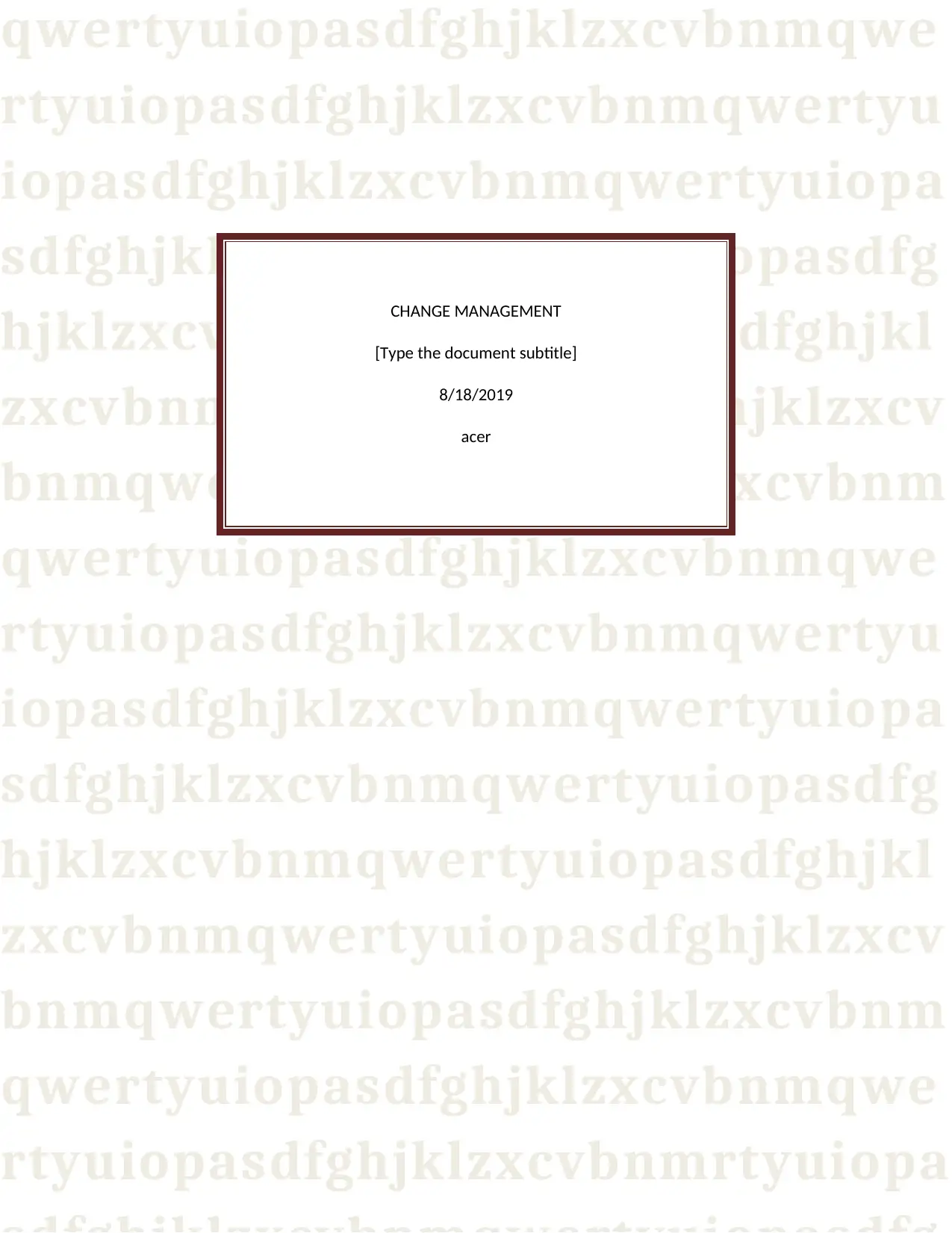
qwertyuiopasdfghjklzxcvbnmqwe
rtyuiopasdfghjklzxcvbnmqwertyu
iopasdfghjklzxcvbnmqwertyuiopa
sdfghjklzxcvbnmqwertyuiopasdfg
hjklzxcvbnmqwertyuiopasdfghjkl
zxcvbnmqwertyuiopasdfghjklzxcv
bnmqwertyuiopasdfghjklzxcvbnm
qwertyuiopasdfghjklzxcvbnmqwe
rtyuiopasdfghjklzxcvbnmqwertyu
iopasdfghjklzxcvbnmqwertyuiopa
sdfghjklzxcvbnmqwertyuiopasdfg
hjklzxcvbnmqwertyuiopasdfghjkl
zxcvbnmqwertyuiopasdfghjklzxcv
bnmqwertyuiopasdfghjklzxcvbnm
qwertyuiopasdfghjklzxcvbnmqwe
rtyuiopasdfghjklzxcvbnmrtyuiopa
CHANGE MANAGEMENT
[Type the document subtitle]
8/18/2019
acer
rtyuiopasdfghjklzxcvbnmqwertyu
iopasdfghjklzxcvbnmqwertyuiopa
sdfghjklzxcvbnmqwertyuiopasdfg
hjklzxcvbnmqwertyuiopasdfghjkl
zxcvbnmqwertyuiopasdfghjklzxcv
bnmqwertyuiopasdfghjklzxcvbnm
qwertyuiopasdfghjklzxcvbnmqwe
rtyuiopasdfghjklzxcvbnmqwertyu
iopasdfghjklzxcvbnmqwertyuiopa
sdfghjklzxcvbnmqwertyuiopasdfg
hjklzxcvbnmqwertyuiopasdfghjkl
zxcvbnmqwertyuiopasdfghjklzxcv
bnmqwertyuiopasdfghjklzxcvbnm
qwertyuiopasdfghjklzxcvbnmqwe
rtyuiopasdfghjklzxcvbnmrtyuiopa
CHANGE MANAGEMENT
[Type the document subtitle]
8/18/2019
acer
Paraphrase This Document
Need a fresh take? Get an instant paraphrase of this document with our AI Paraphraser
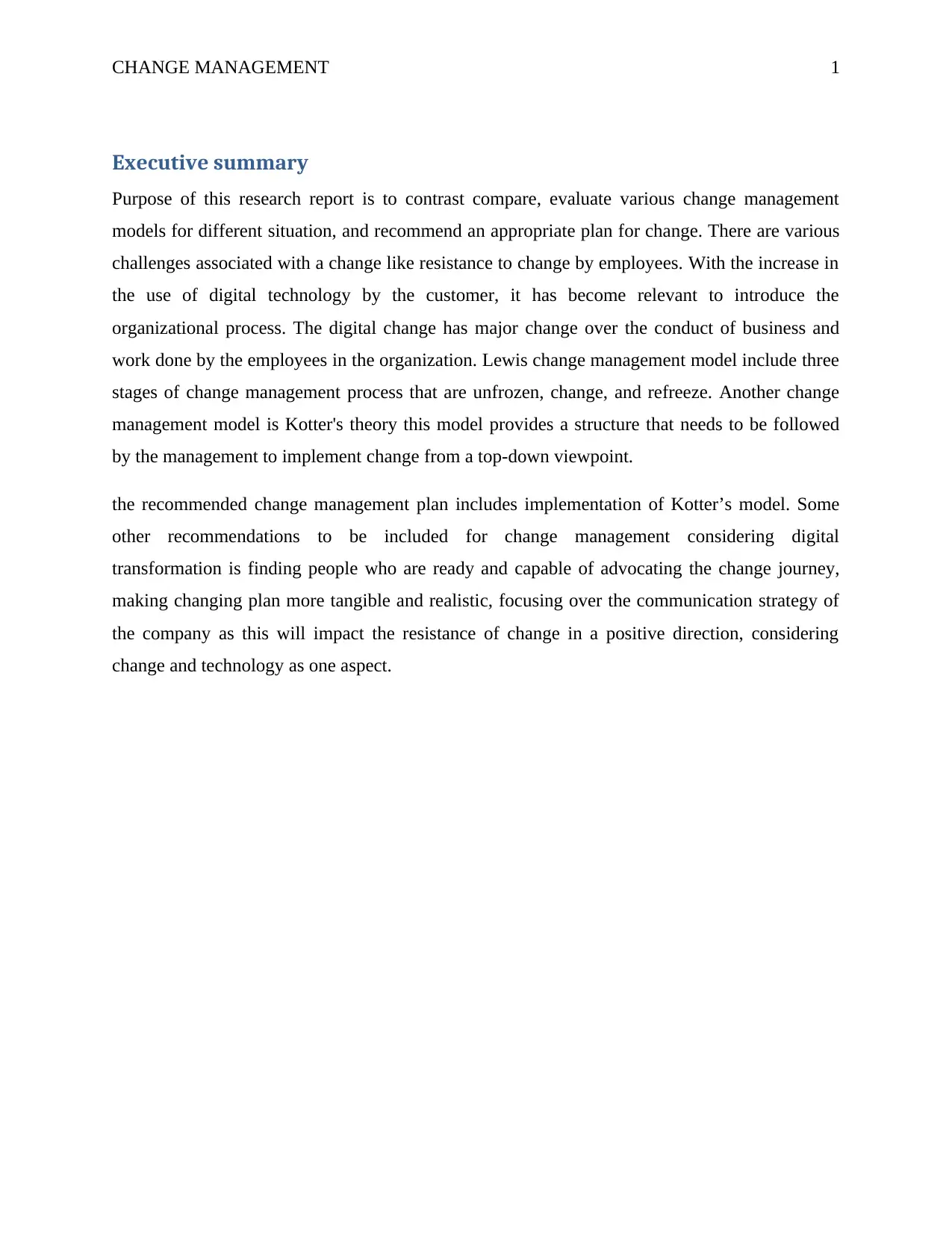
CHANGE MANAGEMENT 1
Executive summary
Purpose of this research report is to contrast compare, evaluate various change management
models for different situation, and recommend an appropriate plan for change. There are various
challenges associated with a change like resistance to change by employees. With the increase in
the use of digital technology by the customer, it has become relevant to introduce the
organizational process. The digital change has major change over the conduct of business and
work done by the employees in the organization. Lewis change management model include three
stages of change management process that are unfrozen, change, and refreeze. Another change
management model is Kotter's theory this model provides a structure that needs to be followed
by the management to implement change from a top-down viewpoint.
the recommended change management plan includes implementation of Kotter’s model. Some
other recommendations to be included for change management considering digital
transformation is finding people who are ready and capable of advocating the change journey,
making changing plan more tangible and realistic, focusing over the communication strategy of
the company as this will impact the resistance of change in a positive direction, considering
change and technology as one aspect.
Executive summary
Purpose of this research report is to contrast compare, evaluate various change management
models for different situation, and recommend an appropriate plan for change. There are various
challenges associated with a change like resistance to change by employees. With the increase in
the use of digital technology by the customer, it has become relevant to introduce the
organizational process. The digital change has major change over the conduct of business and
work done by the employees in the organization. Lewis change management model include three
stages of change management process that are unfrozen, change, and refreeze. Another change
management model is Kotter's theory this model provides a structure that needs to be followed
by the management to implement change from a top-down viewpoint.
the recommended change management plan includes implementation of Kotter’s model. Some
other recommendations to be included for change management considering digital
transformation is finding people who are ready and capable of advocating the change journey,
making changing plan more tangible and realistic, focusing over the communication strategy of
the company as this will impact the resistance of change in a positive direction, considering
change and technology as one aspect.
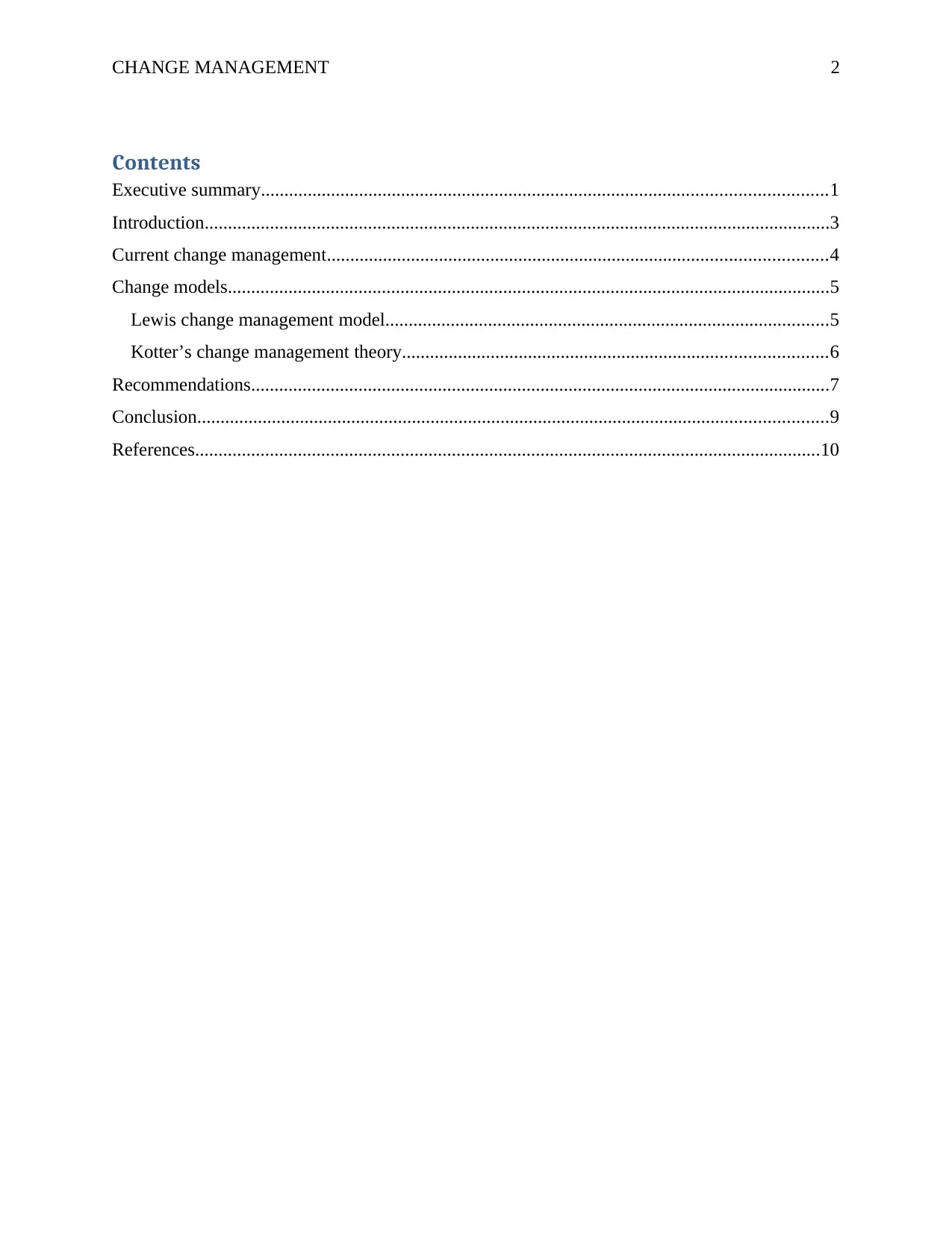
CHANGE MANAGEMENT 2
Contents
Executive summary.........................................................................................................................1
Introduction......................................................................................................................................3
Current change management...........................................................................................................4
Change models.................................................................................................................................5
Lewis change management model...............................................................................................5
Kotter’s change management theory...........................................................................................6
Recommendations............................................................................................................................7
Conclusion.......................................................................................................................................9
References......................................................................................................................................10
Contents
Executive summary.........................................................................................................................1
Introduction......................................................................................................................................3
Current change management...........................................................................................................4
Change models.................................................................................................................................5
Lewis change management model...............................................................................................5
Kotter’s change management theory...........................................................................................6
Recommendations............................................................................................................................7
Conclusion.......................................................................................................................................9
References......................................................................................................................................10
⊘ This is a preview!⊘
Do you want full access?
Subscribe today to unlock all pages.

Trusted by 1+ million students worldwide
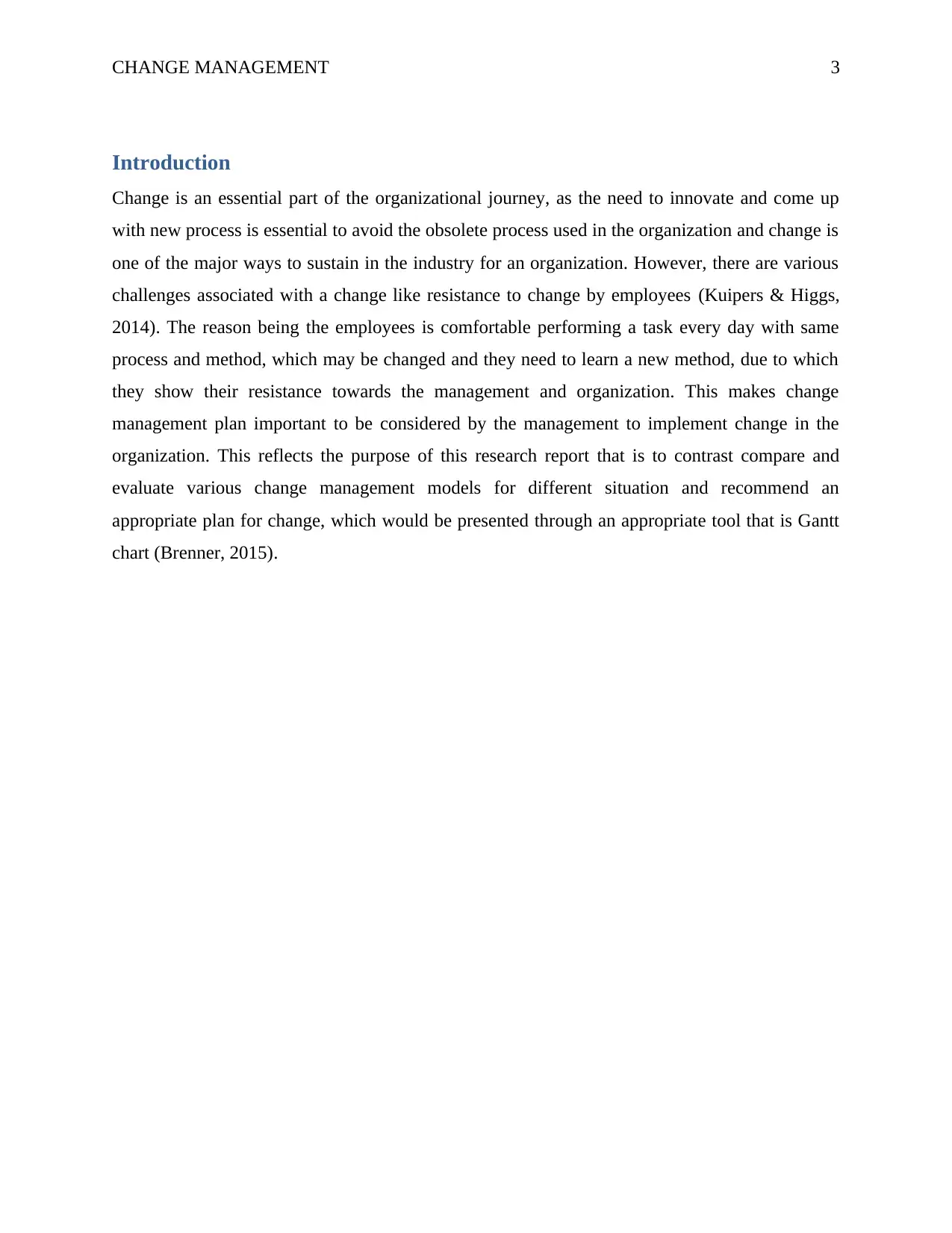
CHANGE MANAGEMENT 3
Introduction
Change is an essential part of the organizational journey, as the need to innovate and come up
with new process is essential to avoid the obsolete process used in the organization and change is
one of the major ways to sustain in the industry for an organization. However, there are various
challenges associated with a change like resistance to change by employees (Kuipers & Higgs,
2014). The reason being the employees is comfortable performing a task every day with same
process and method, which may be changed and they need to learn a new method, due to which
they show their resistance towards the management and organization. This makes change
management plan important to be considered by the management to implement change in the
organization. This reflects the purpose of this research report that is to contrast compare and
evaluate various change management models for different situation and recommend an
appropriate plan for change, which would be presented through an appropriate tool that is Gantt
chart (Brenner, 2015).
Introduction
Change is an essential part of the organizational journey, as the need to innovate and come up
with new process is essential to avoid the obsolete process used in the organization and change is
one of the major ways to sustain in the industry for an organization. However, there are various
challenges associated with a change like resistance to change by employees (Kuipers & Higgs,
2014). The reason being the employees is comfortable performing a task every day with same
process and method, which may be changed and they need to learn a new method, due to which
they show their resistance towards the management and organization. This makes change
management plan important to be considered by the management to implement change in the
organization. This reflects the purpose of this research report that is to contrast compare and
evaluate various change management models for different situation and recommend an
appropriate plan for change, which would be presented through an appropriate tool that is Gantt
chart (Brenner, 2015).
Paraphrase This Document
Need a fresh take? Get an instant paraphrase of this document with our AI Paraphraser
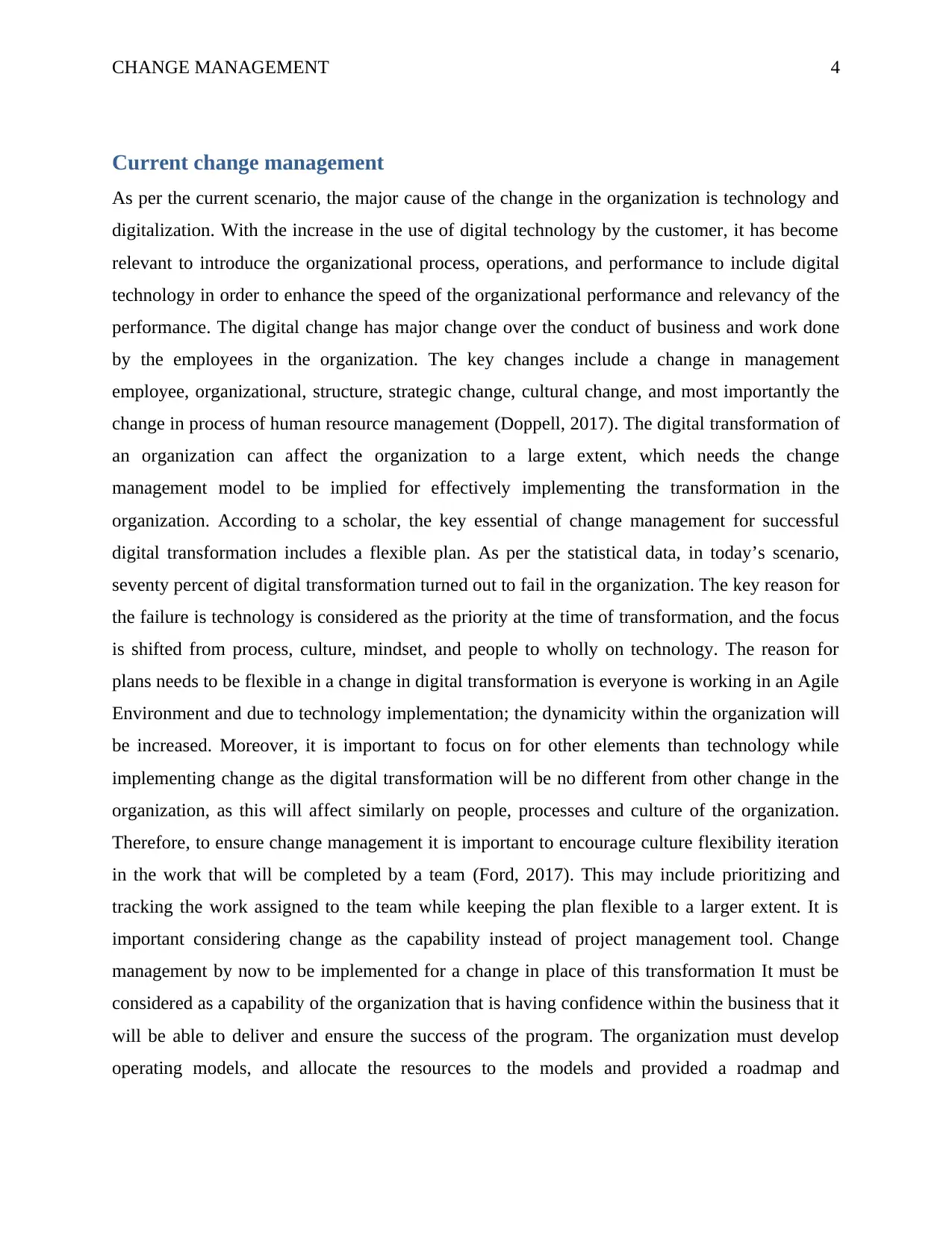
CHANGE MANAGEMENT 4
Current change management
As per the current scenario, the major cause of the change in the organization is technology and
digitalization. With the increase in the use of digital technology by the customer, it has become
relevant to introduce the organizational process, operations, and performance to include digital
technology in order to enhance the speed of the organizational performance and relevancy of the
performance. The digital change has major change over the conduct of business and work done
by the employees in the organization. The key changes include a change in management
employee, organizational, structure, strategic change, cultural change, and most importantly the
change in process of human resource management (Doppell, 2017). The digital transformation of
an organization can affect the organization to a large extent, which needs the change
management model to be implied for effectively implementing the transformation in the
organization. According to a scholar, the key essential of change management for successful
digital transformation includes a flexible plan. As per the statistical data, in today’s scenario,
seventy percent of digital transformation turned out to fail in the organization. The key reason for
the failure is technology is considered as the priority at the time of transformation, and the focus
is shifted from process, culture, mindset, and people to wholly on technology. The reason for
plans needs to be flexible in a change in digital transformation is everyone is working in an Agile
Environment and due to technology implementation; the dynamicity within the organization will
be increased. Moreover, it is important to focus on for other elements than technology while
implementing change as the digital transformation will be no different from other change in the
organization, as this will affect similarly on people, processes and culture of the organization.
Therefore, to ensure change management it is important to encourage culture flexibility iteration
in the work that will be completed by a team (Ford, 2017). This may include prioritizing and
tracking the work assigned to the team while keeping the plan flexible to a larger extent. It is
important considering change as the capability instead of project management tool. Change
management by now to be implemented for a change in place of this transformation It must be
considered as a capability of the organization that is having confidence within the business that it
will be able to deliver and ensure the success of the program. The organization must develop
operating models, and allocate the resources to the models and provided a roadmap and
Current change management
As per the current scenario, the major cause of the change in the organization is technology and
digitalization. With the increase in the use of digital technology by the customer, it has become
relevant to introduce the organizational process, operations, and performance to include digital
technology in order to enhance the speed of the organizational performance and relevancy of the
performance. The digital change has major change over the conduct of business and work done
by the employees in the organization. The key changes include a change in management
employee, organizational, structure, strategic change, cultural change, and most importantly the
change in process of human resource management (Doppell, 2017). The digital transformation of
an organization can affect the organization to a large extent, which needs the change
management model to be implied for effectively implementing the transformation in the
organization. According to a scholar, the key essential of change management for successful
digital transformation includes a flexible plan. As per the statistical data, in today’s scenario,
seventy percent of digital transformation turned out to fail in the organization. The key reason for
the failure is technology is considered as the priority at the time of transformation, and the focus
is shifted from process, culture, mindset, and people to wholly on technology. The reason for
plans needs to be flexible in a change in digital transformation is everyone is working in an Agile
Environment and due to technology implementation; the dynamicity within the organization will
be increased. Moreover, it is important to focus on for other elements than technology while
implementing change as the digital transformation will be no different from other change in the
organization, as this will affect similarly on people, processes and culture of the organization.
Therefore, to ensure change management it is important to encourage culture flexibility iteration
in the work that will be completed by a team (Ford, 2017). This may include prioritizing and
tracking the work assigned to the team while keeping the plan flexible to a larger extent. It is
important considering change as the capability instead of project management tool. Change
management by now to be implemented for a change in place of this transformation It must be
considered as a capability of the organization that is having confidence within the business that it
will be able to deliver and ensure the success of the program. The organization must develop
operating models, and allocate the resources to the models and provided a roadmap and
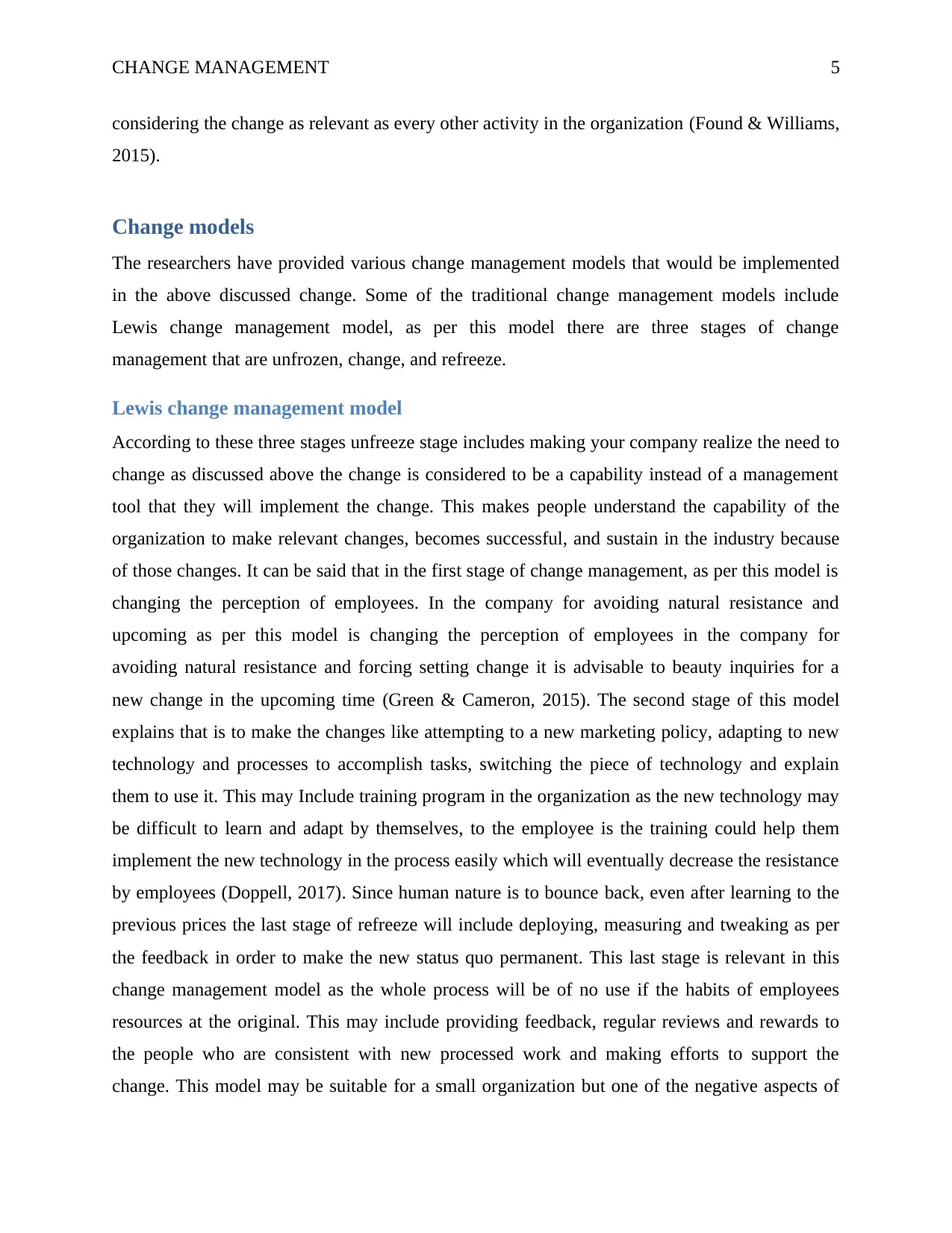
CHANGE MANAGEMENT 5
considering the change as relevant as every other activity in the organization (Found & Williams,
2015).
Change models
The researchers have provided various change management models that would be implemented
in the above discussed change. Some of the traditional change management models include
Lewis change management model, as per this model there are three stages of change
management that are unfrozen, change, and refreeze.
Lewis change management model
According to these three stages unfreeze stage includes making your company realize the need to
change as discussed above the change is considered to be a capability instead of a management
tool that they will implement the change. This makes people understand the capability of the
organization to make relevant changes, becomes successful, and sustain in the industry because
of those changes. It can be said that in the first stage of change management, as per this model is
changing the perception of employees. In the company for avoiding natural resistance and
upcoming as per this model is changing the perception of employees in the company for
avoiding natural resistance and forcing setting change it is advisable to beauty inquiries for a
new change in the upcoming time (Green & Cameron, 2015). The second stage of this model
explains that is to make the changes like attempting to a new marketing policy, adapting to new
technology and processes to accomplish tasks, switching the piece of technology and explain
them to use it. This may Include training program in the organization as the new technology may
be difficult to learn and adapt by themselves, to the employee is the training could help them
implement the new technology in the process easily which will eventually decrease the resistance
by employees (Doppell, 2017). Since human nature is to bounce back, even after learning to the
previous prices the last stage of refreeze will include deploying, measuring and tweaking as per
the feedback in order to make the new status quo permanent. This last stage is relevant in this
change management model as the whole process will be of no use if the habits of employees
resources at the original. This may include providing feedback, regular reviews and rewards to
the people who are consistent with new processed work and making efforts to support the
change. This model may be suitable for a small organization but one of the negative aspects of
considering the change as relevant as every other activity in the organization (Found & Williams,
2015).
Change models
The researchers have provided various change management models that would be implemented
in the above discussed change. Some of the traditional change management models include
Lewis change management model, as per this model there are three stages of change
management that are unfrozen, change, and refreeze.
Lewis change management model
According to these three stages unfreeze stage includes making your company realize the need to
change as discussed above the change is considered to be a capability instead of a management
tool that they will implement the change. This makes people understand the capability of the
organization to make relevant changes, becomes successful, and sustain in the industry because
of those changes. It can be said that in the first stage of change management, as per this model is
changing the perception of employees. In the company for avoiding natural resistance and
upcoming as per this model is changing the perception of employees in the company for
avoiding natural resistance and forcing setting change it is advisable to beauty inquiries for a
new change in the upcoming time (Green & Cameron, 2015). The second stage of this model
explains that is to make the changes like attempting to a new marketing policy, adapting to new
technology and processes to accomplish tasks, switching the piece of technology and explain
them to use it. This may Include training program in the organization as the new technology may
be difficult to learn and adapt by themselves, to the employee is the training could help them
implement the new technology in the process easily which will eventually decrease the resistance
by employees (Doppell, 2017). Since human nature is to bounce back, even after learning to the
previous prices the last stage of refreeze will include deploying, measuring and tweaking as per
the feedback in order to make the new status quo permanent. This last stage is relevant in this
change management model as the whole process will be of no use if the habits of employees
resources at the original. This may include providing feedback, regular reviews and rewards to
the people who are consistent with new processed work and making efforts to support the
change. This model may be suitable for a small organization but one of the negative aspects of
⊘ This is a preview!⊘
Do you want full access?
Subscribe today to unlock all pages.

Trusted by 1+ million students worldwide
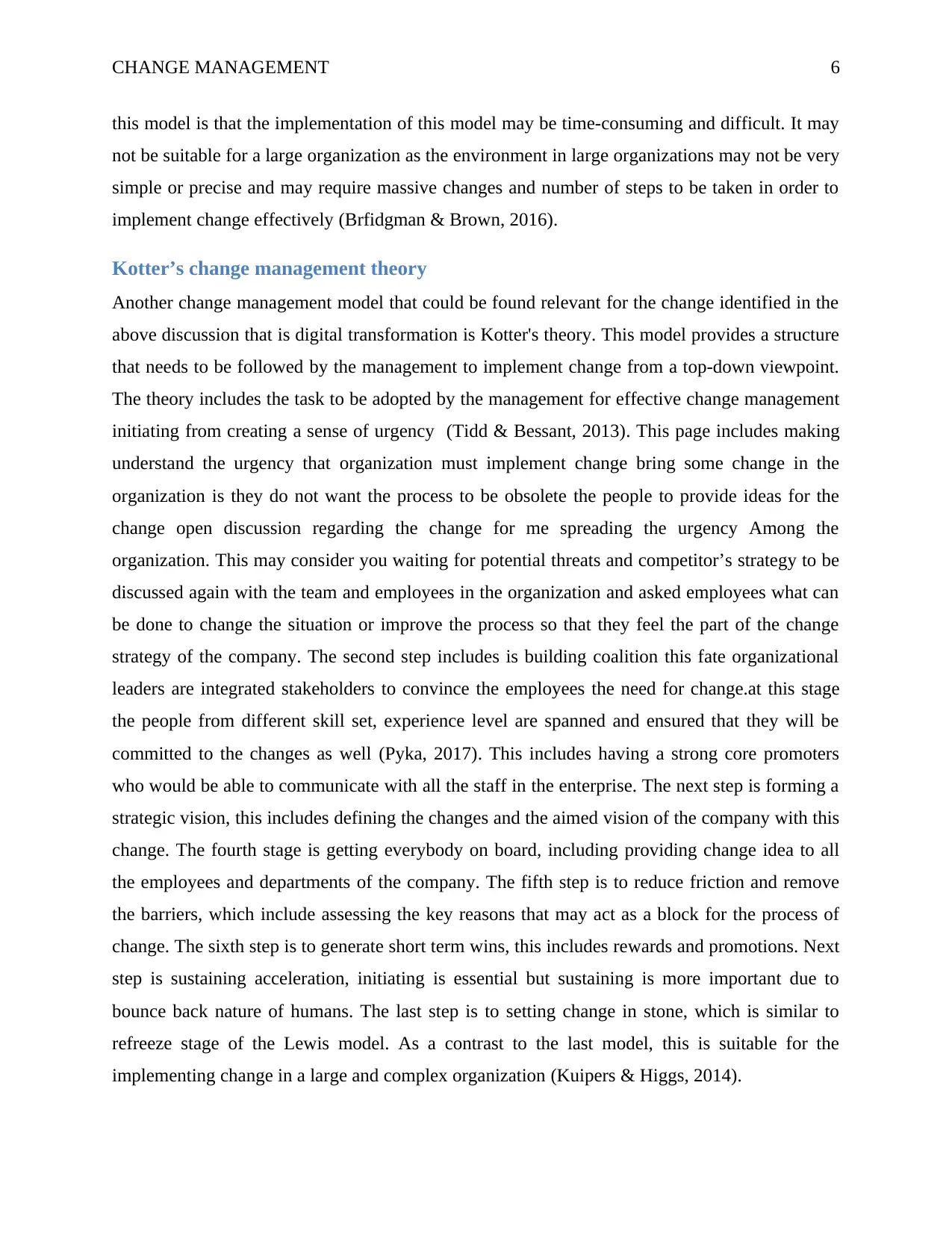
CHANGE MANAGEMENT 6
this model is that the implementation of this model may be time-consuming and difficult. It may
not be suitable for a large organization as the environment in large organizations may not be very
simple or precise and may require massive changes and number of steps to be taken in order to
implement change effectively (Brfidgman & Brown, 2016).
Kotter’s change management theory
Another change management model that could be found relevant for the change identified in the
above discussion that is digital transformation is Kotter's theory. This model provides a structure
that needs to be followed by the management to implement change from a top-down viewpoint.
The theory includes the task to be adopted by the management for effective change management
initiating from creating a sense of urgency (Tidd & Bessant, 2013). This page includes making
understand the urgency that organization must implement change bring some change in the
organization is they do not want the process to be obsolete the people to provide ideas for the
change open discussion regarding the change for me spreading the urgency Among the
organization. This may consider you waiting for potential threats and competitor’s strategy to be
discussed again with the team and employees in the organization and asked employees what can
be done to change the situation or improve the process so that they feel the part of the change
strategy of the company. The second step includes is building coalition this fate organizational
leaders are integrated stakeholders to convince the employees the need for change.at this stage
the people from different skill set, experience level are spanned and ensured that they will be
committed to the changes as well (Pyka, 2017). This includes having a strong core promoters
who would be able to communicate with all the staff in the enterprise. The next step is forming a
strategic vision, this includes defining the changes and the aimed vision of the company with this
change. The fourth stage is getting everybody on board, including providing change idea to all
the employees and departments of the company. The fifth step is to reduce friction and remove
the barriers, which include assessing the key reasons that may act as a block for the process of
change. The sixth step is to generate short term wins, this includes rewards and promotions. Next
step is sustaining acceleration, initiating is essential but sustaining is more important due to
bounce back nature of humans. The last step is to setting change in stone, which is similar to
refreeze stage of the Lewis model. As a contrast to the last model, this is suitable for the
implementing change in a large and complex organization (Kuipers & Higgs, 2014).
this model is that the implementation of this model may be time-consuming and difficult. It may
not be suitable for a large organization as the environment in large organizations may not be very
simple or precise and may require massive changes and number of steps to be taken in order to
implement change effectively (Brfidgman & Brown, 2016).
Kotter’s change management theory
Another change management model that could be found relevant for the change identified in the
above discussion that is digital transformation is Kotter's theory. This model provides a structure
that needs to be followed by the management to implement change from a top-down viewpoint.
The theory includes the task to be adopted by the management for effective change management
initiating from creating a sense of urgency (Tidd & Bessant, 2013). This page includes making
understand the urgency that organization must implement change bring some change in the
organization is they do not want the process to be obsolete the people to provide ideas for the
change open discussion regarding the change for me spreading the urgency Among the
organization. This may consider you waiting for potential threats and competitor’s strategy to be
discussed again with the team and employees in the organization and asked employees what can
be done to change the situation or improve the process so that they feel the part of the change
strategy of the company. The second step includes is building coalition this fate organizational
leaders are integrated stakeholders to convince the employees the need for change.at this stage
the people from different skill set, experience level are spanned and ensured that they will be
committed to the changes as well (Pyka, 2017). This includes having a strong core promoters
who would be able to communicate with all the staff in the enterprise. The next step is forming a
strategic vision, this includes defining the changes and the aimed vision of the company with this
change. The fourth stage is getting everybody on board, including providing change idea to all
the employees and departments of the company. The fifth step is to reduce friction and remove
the barriers, which include assessing the key reasons that may act as a block for the process of
change. The sixth step is to generate short term wins, this includes rewards and promotions. Next
step is sustaining acceleration, initiating is essential but sustaining is more important due to
bounce back nature of humans. The last step is to setting change in stone, which is similar to
refreeze stage of the Lewis model. As a contrast to the last model, this is suitable for the
implementing change in a large and complex organization (Kuipers & Higgs, 2014).
Paraphrase This Document
Need a fresh take? Get an instant paraphrase of this document with our AI Paraphraser
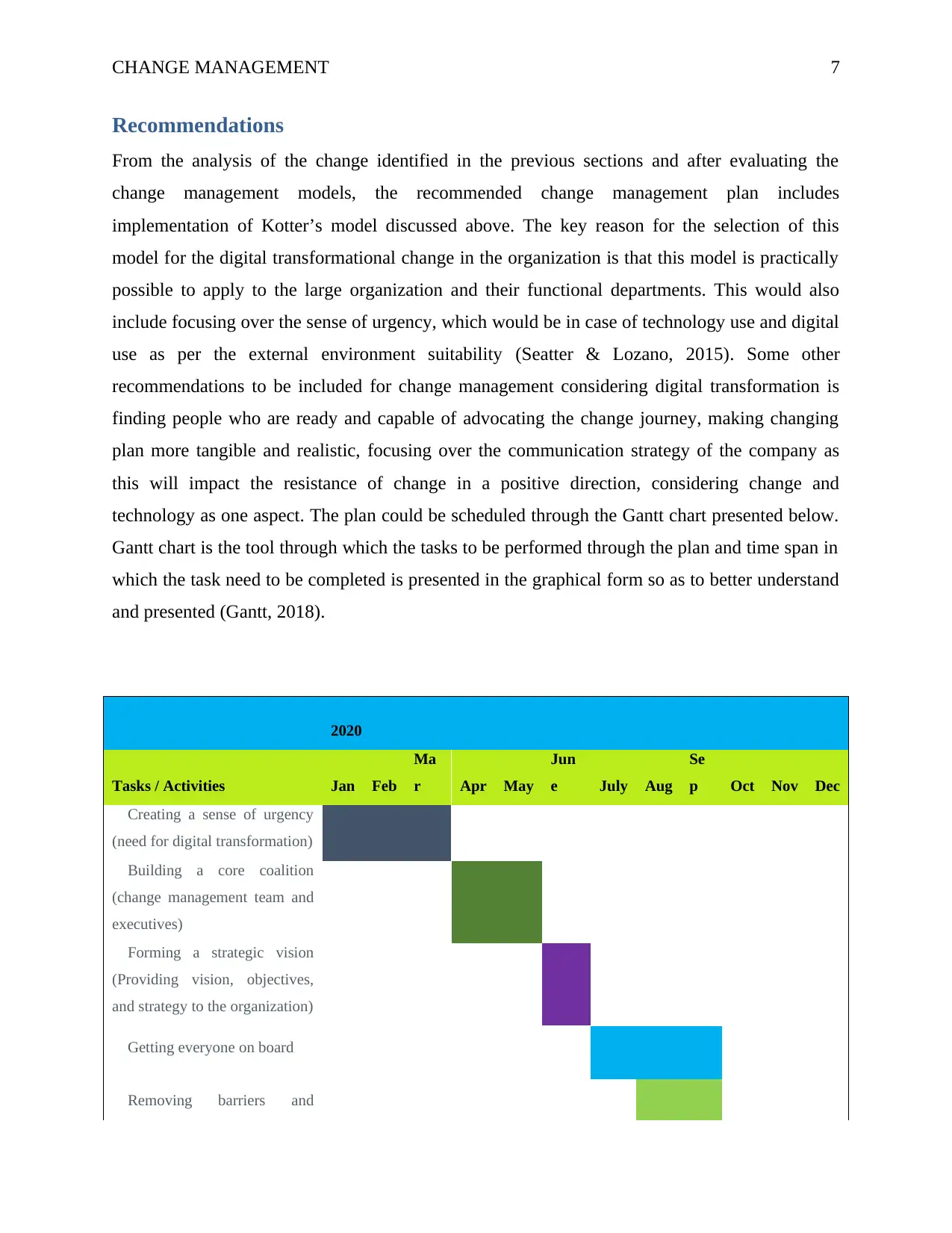
CHANGE MANAGEMENT 7
Recommendations
From the analysis of the change identified in the previous sections and after evaluating the
change management models, the recommended change management plan includes
implementation of Kotter’s model discussed above. The key reason for the selection of this
model for the digital transformational change in the organization is that this model is practically
possible to apply to the large organization and their functional departments. This would also
include focusing over the sense of urgency, which would be in case of technology use and digital
use as per the external environment suitability (Seatter & Lozano, 2015). Some other
recommendations to be included for change management considering digital transformation is
finding people who are ready and capable of advocating the change journey, making changing
plan more tangible and realistic, focusing over the communication strategy of the company as
this will impact the resistance of change in a positive direction, considering change and
technology as one aspect. The plan could be scheduled through the Gantt chart presented below.
Gantt chart is the tool through which the tasks to be performed through the plan and time span in
which the task need to be completed is presented in the graphical form so as to better understand
and presented (Gantt, 2018).
2020
Tasks / Activities Jan Feb
Ma
r Apr May
Jun
e July Aug
Se
p Oct Nov Dec
Creating a sense of urgency
(need for digital transformation)
Building a core coalition
(change management team and
executives)
Forming a strategic vision
(Providing vision, objectives,
and strategy to the organization)
Getting everyone on board
Removing barriers and
Recommendations
From the analysis of the change identified in the previous sections and after evaluating the
change management models, the recommended change management plan includes
implementation of Kotter’s model discussed above. The key reason for the selection of this
model for the digital transformational change in the organization is that this model is practically
possible to apply to the large organization and their functional departments. This would also
include focusing over the sense of urgency, which would be in case of technology use and digital
use as per the external environment suitability (Seatter & Lozano, 2015). Some other
recommendations to be included for change management considering digital transformation is
finding people who are ready and capable of advocating the change journey, making changing
plan more tangible and realistic, focusing over the communication strategy of the company as
this will impact the resistance of change in a positive direction, considering change and
technology as one aspect. The plan could be scheduled through the Gantt chart presented below.
Gantt chart is the tool through which the tasks to be performed through the plan and time span in
which the task need to be completed is presented in the graphical form so as to better understand
and presented (Gantt, 2018).
2020
Tasks / Activities Jan Feb
Ma
r Apr May
Jun
e July Aug
Se
p Oct Nov Dec
Creating a sense of urgency
(need for digital transformation)
Building a core coalition
(change management team and
executives)
Forming a strategic vision
(Providing vision, objectives,
and strategy to the organization)
Getting everyone on board
Removing barriers and
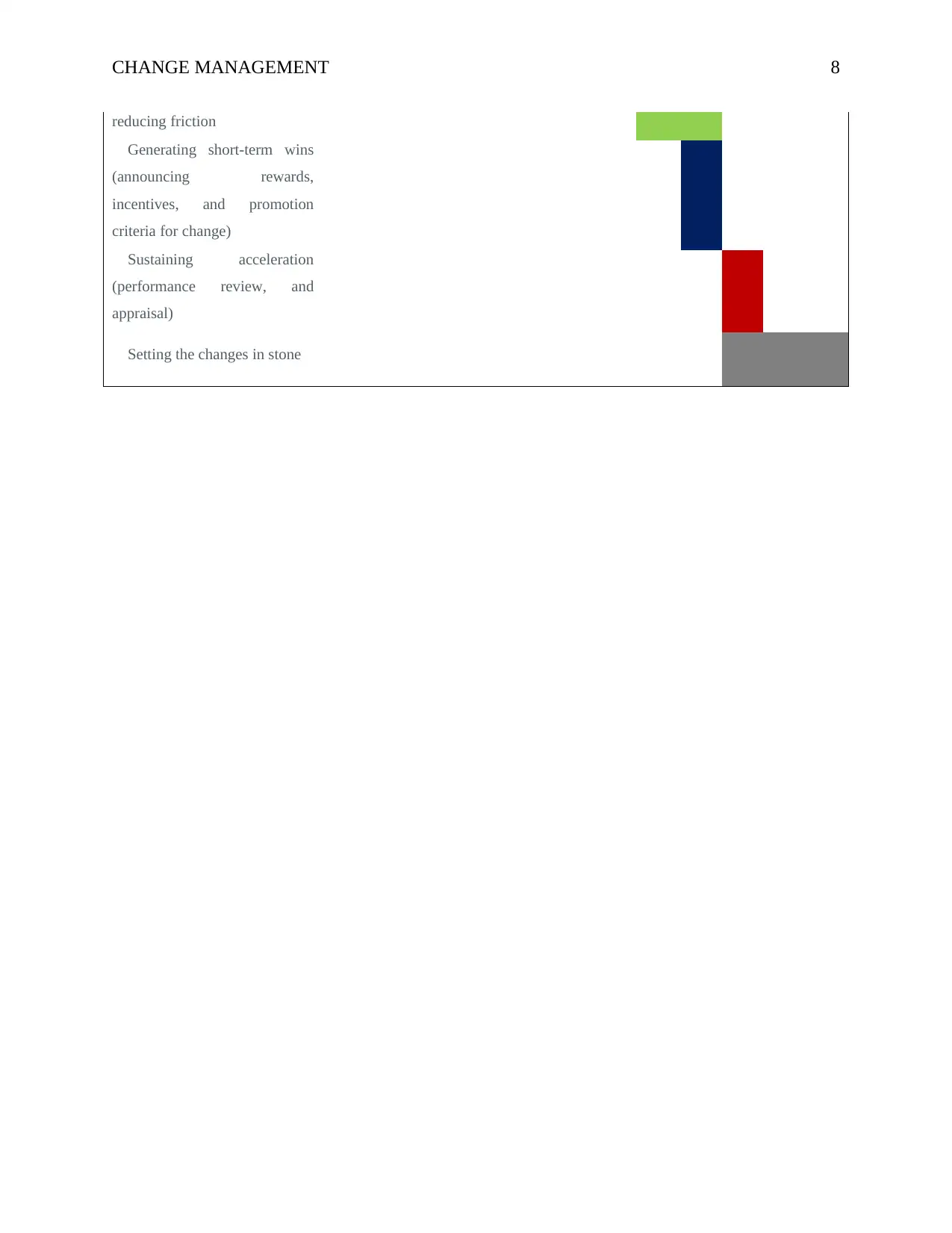
CHANGE MANAGEMENT 8
reducing friction
Generating short-term wins
(announcing rewards,
incentives, and promotion
criteria for change)
Sustaining acceleration
(performance review, and
appraisal)
Setting the changes in stone
reducing friction
Generating short-term wins
(announcing rewards,
incentives, and promotion
criteria for change)
Sustaining acceleration
(performance review, and
appraisal)
Setting the changes in stone
⊘ This is a preview!⊘
Do you want full access?
Subscribe today to unlock all pages.

Trusted by 1+ million students worldwide
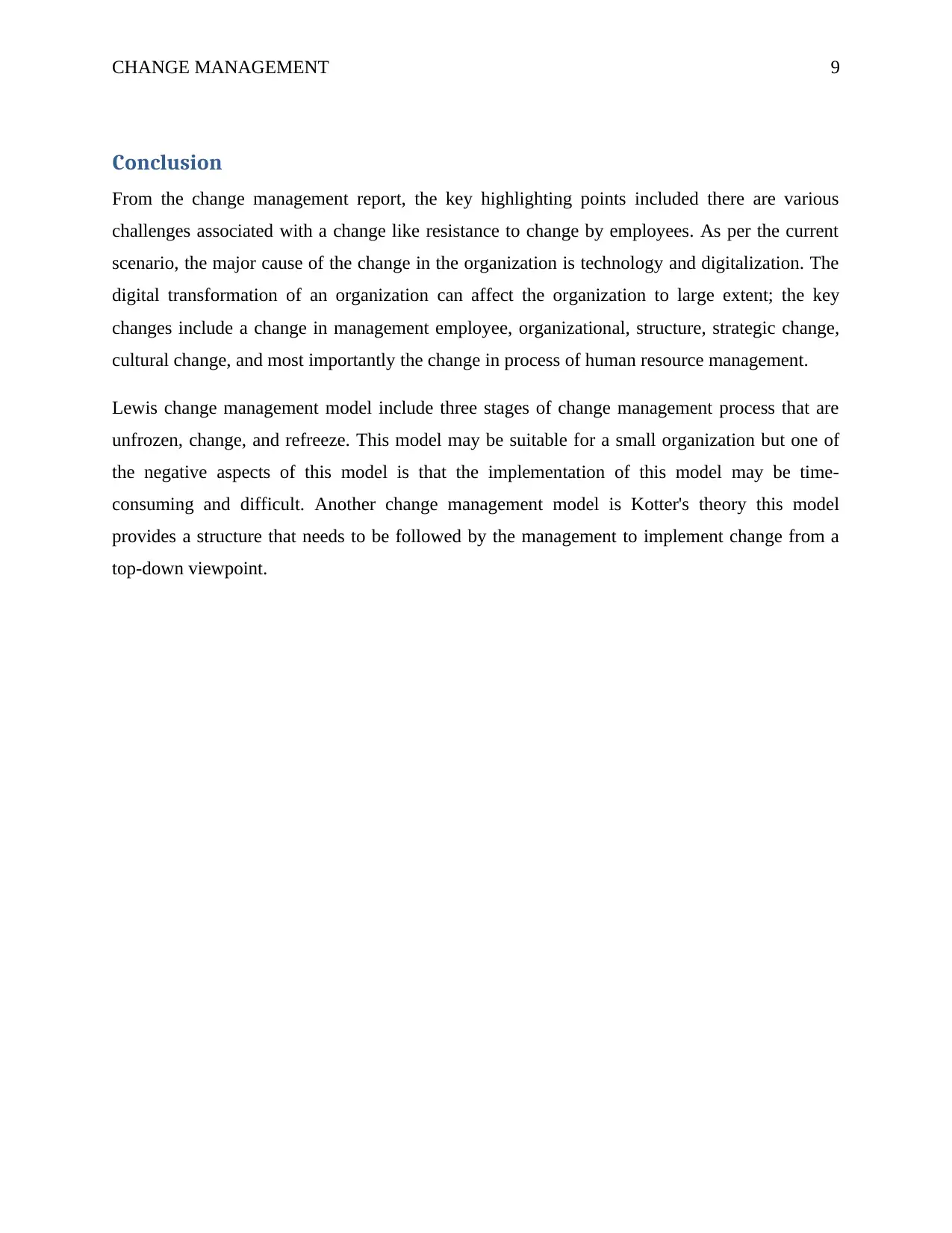
CHANGE MANAGEMENT 9
Conclusion
From the change management report, the key highlighting points included there are various
challenges associated with a change like resistance to change by employees. As per the current
scenario, the major cause of the change in the organization is technology and digitalization. The
digital transformation of an organization can affect the organization to large extent; the key
changes include a change in management employee, organizational, structure, strategic change,
cultural change, and most importantly the change in process of human resource management.
Lewis change management model include three stages of change management process that are
unfrozen, change, and refreeze. This model may be suitable for a small organization but one of
the negative aspects of this model is that the implementation of this model may be time-
consuming and difficult. Another change management model is Kotter's theory this model
provides a structure that needs to be followed by the management to implement change from a
top-down viewpoint.
Conclusion
From the change management report, the key highlighting points included there are various
challenges associated with a change like resistance to change by employees. As per the current
scenario, the major cause of the change in the organization is technology and digitalization. The
digital transformation of an organization can affect the organization to large extent; the key
changes include a change in management employee, organizational, structure, strategic change,
cultural change, and most importantly the change in process of human resource management.
Lewis change management model include three stages of change management process that are
unfrozen, change, and refreeze. This model may be suitable for a small organization but one of
the negative aspects of this model is that the implementation of this model may be time-
consuming and difficult. Another change management model is Kotter's theory this model
provides a structure that needs to be followed by the management to implement change from a
top-down viewpoint.
Paraphrase This Document
Need a fresh take? Get an instant paraphrase of this document with our AI Paraphraser
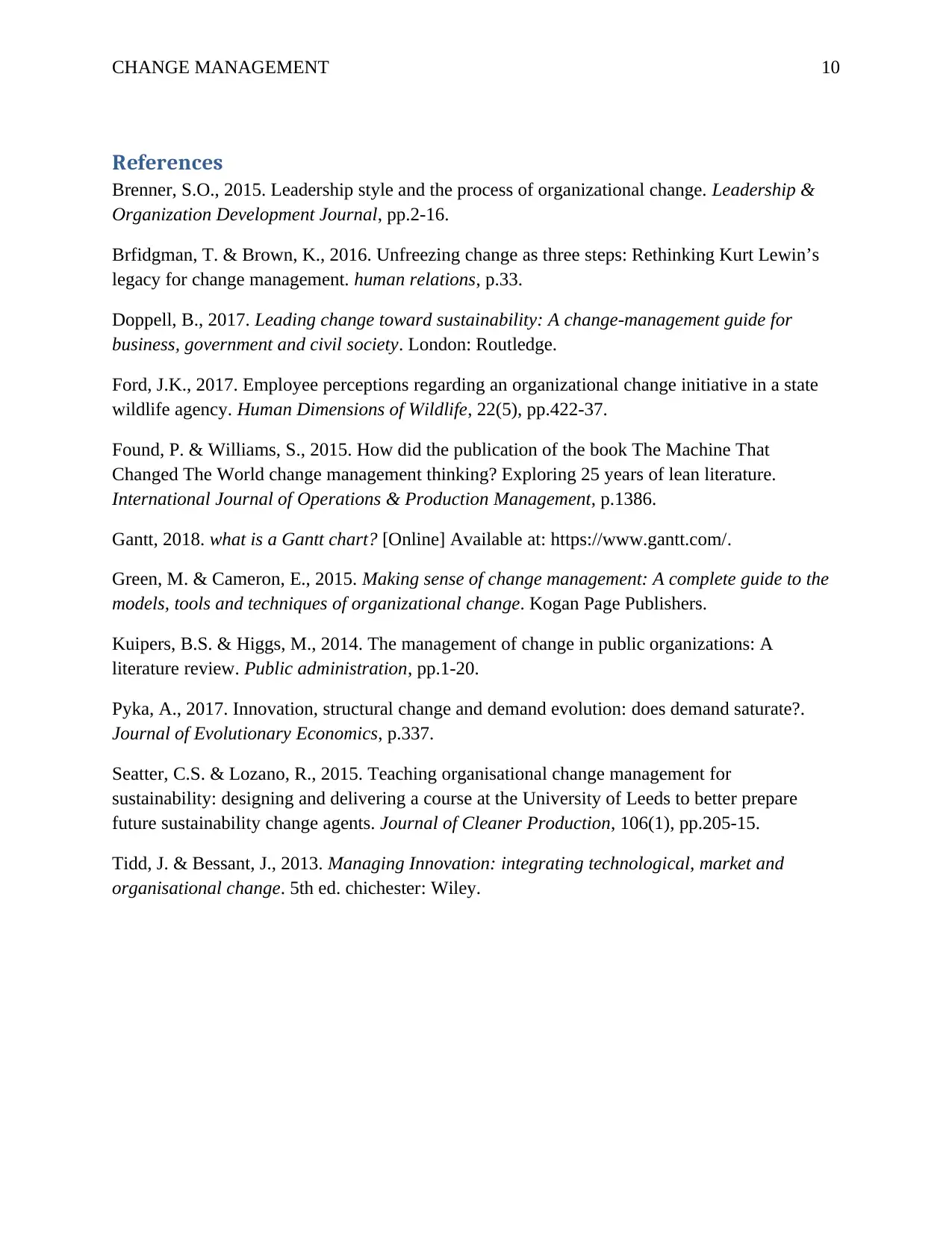
CHANGE MANAGEMENT 10
References
Brenner, S.O., 2015. Leadership style and the process of organizational change. Leadership &
Organization Development Journal, pp.2-16.
Brfidgman, T. & Brown, K., 2016. Unfreezing change as three steps: Rethinking Kurt Lewin’s
legacy for change management. human relations, p.33.
Doppell, B., 2017. Leading change toward sustainability: A change-management guide for
business, government and civil society. London: Routledge.
Ford, J.K., 2017. Employee perceptions regarding an organizational change initiative in a state
wildlife agency. Human Dimensions of Wildlife, 22(5), pp.422-37.
Found, P. & Williams, S., 2015. How did the publication of the book The Machine That
Changed The World change management thinking? Exploring 25 years of lean literature.
International Journal of Operations & Production Management, p.1386.
Gantt, 2018. what is a Gantt chart? [Online] Available at: https://www.gantt.com/.
Green, M. & Cameron, E., 2015. Making sense of change management: A complete guide to the
models, tools and techniques of organizational change. Kogan Page Publishers.
Kuipers, B.S. & Higgs, M., 2014. The management of change in public organizations: A
literature review. Public administration, pp.1-20.
Pyka, A., 2017. Innovation, structural change and demand evolution: does demand saturate?.
Journal of Evolutionary Economics, p.337.
Seatter, C.S. & Lozano, R., 2015. Teaching organisational change management for
sustainability: designing and delivering a course at the University of Leeds to better prepare
future sustainability change agents. Journal of Cleaner Production, 106(1), pp.205-15.
Tidd, J. & Bessant, J., 2013. Managing Innovation: integrating technological, market and
organisational change. 5th ed. chichester: Wiley.
References
Brenner, S.O., 2015. Leadership style and the process of organizational change. Leadership &
Organization Development Journal, pp.2-16.
Brfidgman, T. & Brown, K., 2016. Unfreezing change as three steps: Rethinking Kurt Lewin’s
legacy for change management. human relations, p.33.
Doppell, B., 2017. Leading change toward sustainability: A change-management guide for
business, government and civil society. London: Routledge.
Ford, J.K., 2017. Employee perceptions regarding an organizational change initiative in a state
wildlife agency. Human Dimensions of Wildlife, 22(5), pp.422-37.
Found, P. & Williams, S., 2015. How did the publication of the book The Machine That
Changed The World change management thinking? Exploring 25 years of lean literature.
International Journal of Operations & Production Management, p.1386.
Gantt, 2018. what is a Gantt chart? [Online] Available at: https://www.gantt.com/.
Green, M. & Cameron, E., 2015. Making sense of change management: A complete guide to the
models, tools and techniques of organizational change. Kogan Page Publishers.
Kuipers, B.S. & Higgs, M., 2014. The management of change in public organizations: A
literature review. Public administration, pp.1-20.
Pyka, A., 2017. Innovation, structural change and demand evolution: does demand saturate?.
Journal of Evolutionary Economics, p.337.
Seatter, C.S. & Lozano, R., 2015. Teaching organisational change management for
sustainability: designing and delivering a course at the University of Leeds to better prepare
future sustainability change agents. Journal of Cleaner Production, 106(1), pp.205-15.
Tidd, J. & Bessant, J., 2013. Managing Innovation: integrating technological, market and
organisational change. 5th ed. chichester: Wiley.
1 out of 11
Related Documents
Your All-in-One AI-Powered Toolkit for Academic Success.
+13062052269
info@desklib.com
Available 24*7 on WhatsApp / Email
![[object Object]](/_next/static/media/star-bottom.7253800d.svg)
Unlock your academic potential
Copyright © 2020–2025 A2Z Services. All Rights Reserved. Developed and managed by ZUCOL.




